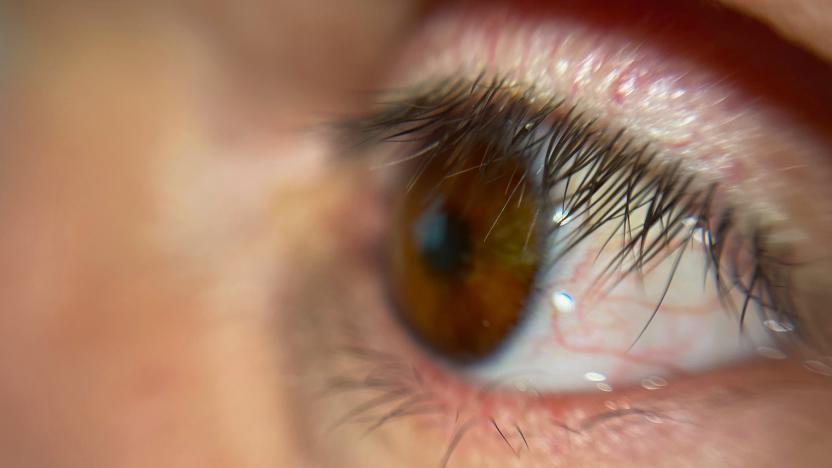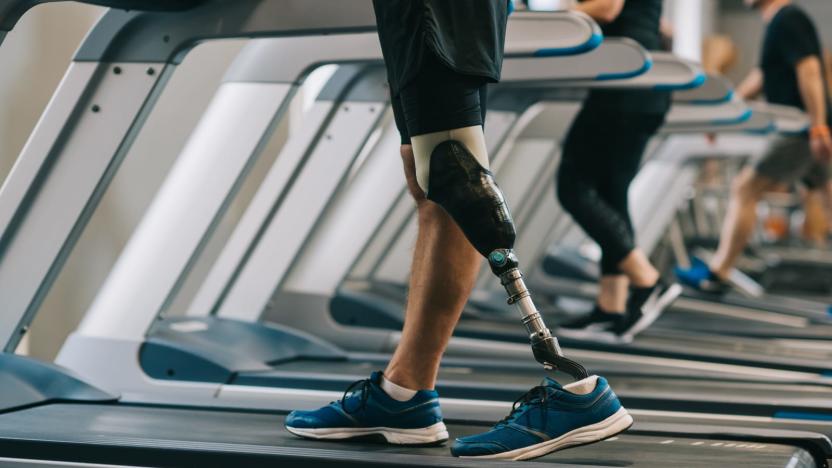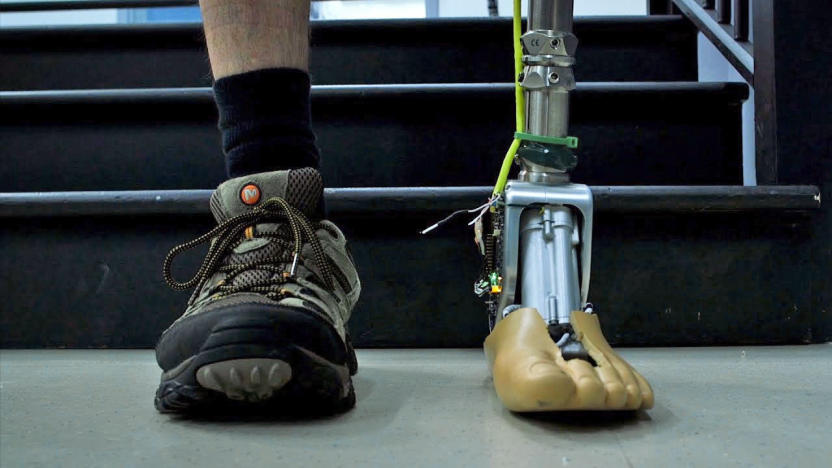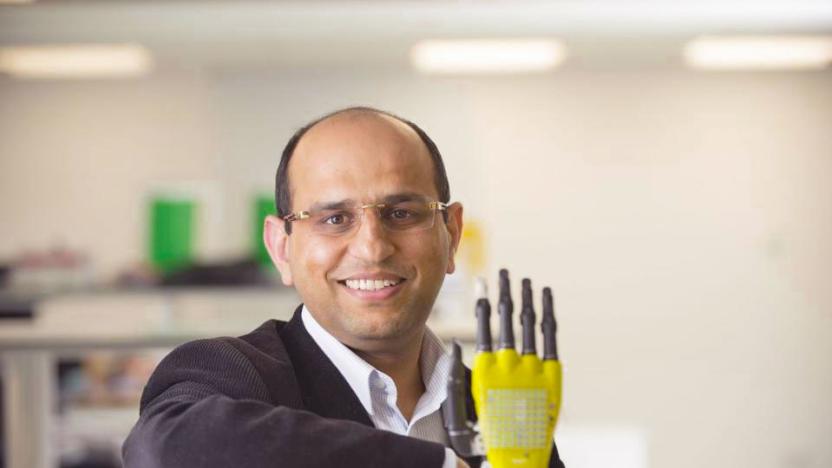prosthesis
Latest

Patient receives the world's first fully 3D-printed prosthetic eye
A patient has been fitted with a highly realistic 3D printed prosthetic eye for the first time ever.

New prosthetic legs let amputees feel their foot and knee in real-time
There's been a lot of research into how to give robots and prosthesis wearers a sense of touch, but it has focused largely on the hands. Now, researchers led by ETH Zurich want to restore sensory feedback for leg amputees, too. In a paper published in Nature Medicine today, the team describes how they modified an off-the-shelf prosthetic leg with sensors and electrodes to give wearers a sense of knee movement and feedback from the sole of the foot on the ground. While their initial sample size was small -- just two users -- the results are promising.

Smart prosthetic ankle can adapt to uneven ground
Prosthetic limbs have evolved considerably from the rudimentary wooden appendages of just a few decades ago. They can be bionic, brain-controlled and loaded with features -- and even mimic the sense of touch. But they're still a way off truly replicating the real thing, largely because of issues imitating the many subtle movements and sensations that come naturally to real limbs. Now, however, a new prosthetic ankle is overcoming these challenges.

Artificial skin with solar cells could power prosthetics
Researchers at Glasgow University have successfully developed a new type of artificial skin that is more sensitive than our own. Made of just a single atomic layer of graphene, the new soft feeling epidermis functions as its own sophisticated touch sensor. If that wasn't impressive enough, this artificial 'skin' is also entirely self-powered. Housing a solar panel hidden under its graphene layer, the material manages to absorb over 98 percent of the light available, relying only on the sun to power it.

Cancer patient receives a 3D-printed jaw
If you lose your lower jaw to cancer, you don't have many options for prosthetics. At that size, traditional clay is so heavy and unwieldy that you can only wear it for a few hours at a time. Indiana University's Dr. Travis Bellicchi and team have developed a much better alternative, though. He recently gave tongue cancer patient Shirley Anderson a 3D-printed jaw after losing his natural jaw to the side effects of radiation treatments. The digitally-modeled piece is not only much lighter, but far more natural-looking -- the creators could create more natural borders and account for fine details like skin pores. The result is good enough that Anderson could comfortably wear the prosthesis in public without drawing significant attention.

Gripping objects takes much more brain power than we thought
Researchers from Brown University have made a discovery about how the human brain operates when gripping an object. Previously, it's been assumed that the mind had a short, single command to drive the hand, but in reality it's much more complex than that. With this new information, it's hoped that engineers will be able to build prosthetic limbs that are significantly more responsive. In addition, the finds could also go some way to helping develop new tools for people with severe paralysis.

Researchers manipulate electrical signals to give prosthetic limbs a sense of touch
Adding the sense of touch to prosthetic limbs could significantly improve an amputee's quality of life, so there's a long list of researchers trying to make it happen. Some of those scientists make up one team out of Cleveland, who -- according to their paper recently published in Science -- have successfully recreated the sense of touch for two men missing an arm in a lab setting. Just like a recent experiment conducted by a team from the EU, this group implanted electrodes around three main nerves in the test subjects' arm stumps. A machine then sends electrical signals between the electrodes and the prosthesis when it's attached, something which, the subjects said, felt like electric tingles at first.

This robotic prosthesis gives drummers a third arm
For many drummers, losing part of an arm could represent a career-ending tragedy. Not Jason Barnes, however. Georgia Tech professor Gil Weinberg has built a robotic prosthesis that not only restores much of Barnes' musical prowess, but effectively gives him a third arm. The wearable offers direct control of one drumstick using bicep muscles; a second, automated drumstick monitors Barnes' timing and plays in sync at a customizable pace, creating a sound that ordinary humans can't match. As you might imagine, the robotic arm has advantages for metal and other musical styles where complex drumming is essential. However, Weinberg also sees uses for the technology in other fields -- astronauts and surgeons could perform complicated tasks in harmony with robots, for example. You can catch a brief demo of Barnes' augmented skills in the video below, and you can check it out in person at Kennesaw State University's Robotic Musicianship Demonstration on March 22nd. [Image credit: Rob Felt/Georgia Tech, Flickr]

Researchers tout progress with brain-controlled robotic legs
While some mind-control technologies may not amount to much more than gimmicks, there's also plenty of serious research being done in the field -- particularly when it comes to artificial limbs. So far, the majority of that work has focused on robotic arms, but a team of researchers from the Veterans Affairs Medical Center in Long Beach, California have now made some progress with a robotic leg prosthesis controlled by EEG signals. As you might expect, things remain a bit limited at this point -- not amounting to much more than the ability to start and stop -- but the researchers say they've been able to achieve a 100 percent response rate with no "false alarms," and that the results are promising enough to begin tackling additional degrees of freedom like turning and sitting. What's more, while the system has so far only been tested on able-bodied individuals, the researchers hope that it will eventually be able to aid those with spinal cord injuries and aid in rehabilitation. You can get a quick look at it on video after the break.

Double amputee Oscar Pistorius will race in the London Olympic games
Four years ago, double amputee Oscar Pistorius -- aka the Blade Runner -- was battling bureaucracy (and his own ability) for the chance to compete in the Beijing Olympics. He might not have made the cut for China, but this time around he's secured his ticket to London. The South African athlete was already penned in for the 4 x 400 meters relay, and will now also compete in the singles 400 meters -- said to be his favorite distance. The South African Olympic committee made a last-minute decision to include Pistorius in the team, making him the first amputee track athlete to compete in the full Olympic games. An amazing achievement in its own right, but a race victory on top of the bureaucratic one would surely be the ultimate finish.

ITK's Handroid: a softer, gentler robotic hand (video)
Most robotic hands are built with a series of individual motors in each joint, making them heavy, expensive and prone to gripping everything with the subtlety of a vice. Japan's ITK thinks it's solved those problems with Handroid -- designed with cords that mimic the muscles in our meat-paws. No motors mean it's far lighter than the standard Terminator design, and it's controlled with a glove that allows it to mirror the operator's movement as it happens. ITK wants to sell Handroid for the bargain price of $6,500 by 2013 for use in environments too dangerous for humans, but because it's so light and cheap it could also see use as a medical prosthesis. You can see how the device works in the video after the break.

Researchers build synthetic synapse circuit, prosthetic brains still decades away
Building a franken-brain has long been a holy grail of sorts for scientists, but now a team of engineering researchers have made what they claim to be a significant breakthrough towards that goal. Alice Parker and Chongwu Zhou of USC used carbon nanotubes to create synthetic synapse circuits that mimic neurons, the basic building blocks of the brain. This could be invaluable to AI research, though the team still hasn't tackled the problem of scope -- our brains are home to 100 billion neurons, each of which has 10,000 synapses. Moreover, these nanotubes are critically lacking in plasticity -- they can't form new connections, produce new neurons, or adapt with age. All told, the scientists say, we're decades away from having fake brains -- or even sections of it -- but if the technology advances as they hope it will, people might one day be able to recover from devastating brain injuries and drive cars smart enough to avert deadly accidents.

AMO Arm pneumatic prosthetic does mind-control on the cheap
We're no strangers to amputees moving stuff with their minds -- for that matter, a thought-controlled prosthetic isn't really new to us, either -- but the pneumatic arm you see here isn't like other intelligent limbs. Unlike most mind-operated prosthesis, the Artificial Muscle-Operated (AMO) Arm doesn't require invasive surgery, and according to its inventors, it costs a quarter of the price to make. Here's how the thing works: the host human wears a headset that sends brain signals to a chip in the arm that then matches those signals to a database of related actions, triggering a series of pneumatic pumps and valves to move the limb. Thus, if the wearer thinks 'up,' the arm moves up. The AMO Arm's creators, a pair of undergraduate biomed students, say that not only is their invention a steal to produce, but it also takes just minutes to acclimate to, which has us wondering, do you have to be missing an arm to get a hold of one of these things? You know, we can always use an extra hand. Full PR after the break.

Power Knee motorized prosthetic officially available in US, Europe -- race of cyborgs still in infancy
We reported on Ossur's robotic prosthetic back in 2009, and now amputees in Europe and the United States have become the first official recipients of the Power Knee. According to the company, "the world's first and only motor-powered prosthetic knee" was recently approved for reimbursement by the German National Health System, covered by private insurance in France and the UK, and picked up by select healthcare providers in the US. Power Knee combines "artificial intelligence," motion sensors, and wireless communication to learn and adjust to the walking style of its users -- that's one small step for real-life cyborgs and one giant leap for prosthetic technology.

Artificial retina reconstructs normal vision in mice, human trials next
Scientists have been working on artificial retinas for years, and while the main focus of research has been to increase the amount of light captured, a study led by Sheila Nirenberg, PhD, has taken a different tack. The new system being devised at Weill Cornell Medical College better mimics frontline photoreceptor cells, making it easier for the ganglion cells to output a more accurate image. "If you want to really restore normal vision, you have to know the retina's code," Nirenberg said. "Once you have that, the door is open to the possibility of restoring normal vision." When researchers performed tests with mice, they found that those with the new system reconstructed more details (the second image, above) than those without (image three, above). "Incorporating the [more accurate] code jumped the system's performance up to normal levels - that is, there was enough information to reconstruct faces, newsprint, landscapes, essentially anything," Nirenberg said. The next step? Coordinating with other researchers to test the technology on human participants.

New prosthesis sends feedback to the brain, might alleviate phantom pain
Even as prosthetic technology advances, the problem of phantom limb sensation persists. Essentially pain, pressure, or some other stimulus attributed by the brain to a limb that has been lost, the exact cause for this is unknown -- and it's a very real problem for amputees. Hoping to better understand (and someday maybe eliminate) the phenomenon, researchers at the University of Jena in Germany have developed a prosthesis that uses sensors and a stimulation unit to send feedback from the patient's artificial hand back to the brain, offering some relief to the individual in the process. So far, the team has had some success, but as the school's Dr. Thomas Weiss points out, there is quite a bit of work yet to be done to determine if "the hand is helpful to only a few people or if it is a therapeutic for all wearers of artificial limbs."

DARPA-funded prosthetic arm reaches phase three, would-be cyborgs celebrate
Last we heard from Johns Hopkins University's Applied Physics Laboratory, it wanted a neurally-controlled bionic arm by 2009. Needless to say, the school overshot that goal by a tiny bit, and have now been beaten (twice) to the punch. But DARPA sees $34.5 million worth of promise in their third and final prototype, which will enable the nine pound kit (with 22 degrees of freedom and sensory feedback) to begin clinical trials. Rechristened the Modular Prosthetic Limb, it will be grafted onto as many as five real, live persons, the first within the year. Using the targeted muscle reinnervation technique pioneered at the Rehabilitation Institute of Chicago, patients will control these arms directly with their thoughts, and for their sakes and the fate of humanity, hopefully not the other way around. Press release after the break.

Bio-electronic implant seeks to restore partial sight
We've seen initiatives all over the globe created in an attempt to beat blindness, but researchers based at MIT are feeling fairly confident that their development is within a few years of being able to "restore partial sight to people who have slowly gone blind because of degenerative diseases of the retina." The bio-electronic implant, which is about the size of a pencil eraser, would actually sit behind the retina at the back of the eyeball, and images would be transmitted to the brain "via a connector the width of a human hair." As it stands, an FDA grant application is already in the works, and the scientists are hoping to have it implanted in an animal as early as this summer. Still, the solution only works for folks who "were once able to see and have partially intact optic nerve cells" -- those who were blind from birth or suffer from glaucoma are unfortunately ineligible for the procedure.[Thanks, Rusty]

Dean Kamen's robo-arm awaits clinical trials
Apparently somewhere along the way Dean Kamen's robo-prosthestesis came to be called the Luke arm (care to guess why?), and according to the IEEE Spectrum blog, it's gearing up to undergo Food and Drug Administration trials pending DARPA's final thumbs-up, which would put the project in motion. Be sure to check out the rest of the profile of the arm's development, which is well worth the read.

Prosthetic-limbed runner disqualified from Olympics
Oscar Pistorius, a double-amputee sprinter, has been denied a shot at the Olympics... for being too fast. The runner -- who uses carbon-fiber, prosthetic feet -- was reviewed by the International Association of Athletics Federations (or IAAF), a review which found the combination of man and machine to be too much for its purely human competitors. According to the IAAF report, the "mechanical advantage of the blade in relation to the healthy ankle joint of an able bodied athlete is higher than 30-percent." Additionally, Pistorius uses 25-percent less energy than average runners due to the artificial limbs, therefore giving him an unfair advantage on the track... or so they say. Oscar is expected to appeal the decision, saying a lack of variables explored by the single scientific study calls for deeper investigation into the matter. Our suggestion? Prosthetic legs for all![Via Medgadget]











